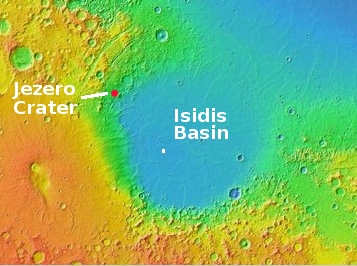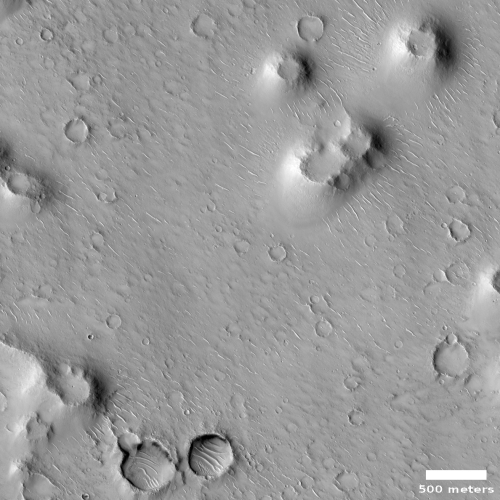Isidis Basin, on whose margin Perseverance will roam

Today’s cool image to the right, cropped and reduced to post here, highlights the floor of one of Mars’ largest basins, dubbed Isidis Planitia, and located at the transition zone between the planet’s northern lowland plains and the southern cratered highlands.
The overview map below of Isidis Basin provides some context. The white box shows where this particular image is located. Jezero Crater, indicated by the red circle (which is also about the size of the crater), is where the rover Perseverance is going to land and roam come February 2021, should all go well. For scale, Isidis is about the size of the eastern half of the United States. If Chicago was located at Jezero Crater, Baltimore would be on the basin’s eastern edge, at around 4 o’clock.
This particular section of the full photo, taken on April 5, 2020 by the high resolution camera on Mars Reconnaissance Orbiter (MRO), shows many features very typical of the floor of Isidis Basin, which also immediately reveal a great deal about its possible history.
In this small snippet we can see what at first glance appear to be pedestal craters standing up like mesas, with ordinary craters scattered about on that lower surrounding terrain. Clearly, if these are pedestal craters they had to have been created first, and then over a very long time erosion processes ate away at that plain, leaving these pedestals (which had become resistant to erosion because the impact had packed their material together and made it harder) behind as mesas.
Then, after this period of erosion was complete enough additional time was required for at least one or two rounds of cratering to occur, leaving behind the many more younger craters on the plain floor, many of which are now partly buried by dust and sand.
The problem is that these mesas are almost certainly not pedestal craters, despite their appearance. Most such craters are found at much higher latitudes, above 30 degrees latitude. Instead, scientists believe that these are cones formed by volcanic processes, not impact.
Isidis is thought to have been created around 4 billion years ago by an large impact [pdf]. Since then volcanic processes followed by the long slow erosion caused by the wind of Mars’ thin atmosphere as well as the planet’s cyclical and changing climate have sculptured its floor.
The cones are thought to have formed during that volcanic period in the basin’s first billion years. Some scientists think the process that produced them was purely volcanic, others think that water ice might have also been involved. The latter theory has a problem in that it requires an ice sheet at the low equatorial latitudes of Isidis. Though this is not impossible, considering the wide swings in the planet’s rotational tilt that is thought to cause large cyclical climate changes, it has been difficult so far to come up with any scenario that makes it possible.
At this point no theory is strongly favored. The data is simply too inconclusive. We really don’t know what happened here precisely, and likely won’t know until we can put footprints on the ground and get a better understanding of Mars’ entire geological and climate history.
On Christmas Eve 1968 three Americans became the first humans to visit another world. What they did to celebrate was unexpected and profound, and will be remembered throughout all human history. Genesis: the Story of Apollo 8, Robert Zimmerman's classic history of humanity's first journey to another world, tells that story, and it is now available as both an ebook and an audiobook, both with a foreword by Valerie Anders and a new introduction by Robert Zimmerman.
The print edition can be purchased at Amazon or from any other book seller. If you want an autographed copy the price is $60 for the hardback and $45 for the paperback, plus $8 shipping for each. Go here for purchasing details. The ebook is available everywhere for $5.99 (before discount) at amazon, or direct from my ebook publisher, ebookit. If you buy it from ebookit you don't support the big tech companies and the author gets a bigger cut much sooner.
The audiobook is also available at all these vendors, and is also free with a 30-day trial membership to Audible.
"Not simply about one mission, [Genesis] is also the history of America's quest for the moon... Zimmerman has done a masterful job of tying disparate events together into a solid account of one of America's greatest human triumphs."--San Antonio Express-News

Today’s cool image to the right, cropped and reduced to post here, highlights the floor of one of Mars’ largest basins, dubbed Isidis Planitia, and located at the transition zone between the planet’s northern lowland plains and the southern cratered highlands.
The overview map below of Isidis Basin provides some context. The white box shows where this particular image is located. Jezero Crater, indicated by the red circle (which is also about the size of the crater), is where the rover Perseverance is going to land and roam come February 2021, should all go well. For scale, Isidis is about the size of the eastern half of the United States. If Chicago was located at Jezero Crater, Baltimore would be on the basin’s eastern edge, at around 4 o’clock.
This particular section of the full photo, taken on April 5, 2020 by the high resolution camera on Mars Reconnaissance Orbiter (MRO), shows many features very typical of the floor of Isidis Basin, which also immediately reveal a great deal about its possible history.
In this small snippet we can see what at first glance appear to be pedestal craters standing up like mesas, with ordinary craters scattered about on that lower surrounding terrain. Clearly, if these are pedestal craters they had to have been created first, and then over a very long time erosion processes ate away at that plain, leaving these pedestals (which had become resistant to erosion because the impact had packed their material together and made it harder) behind as mesas.
Then, after this period of erosion was complete enough additional time was required for at least one or two rounds of cratering to occur, leaving behind the many more younger craters on the plain floor, many of which are now partly buried by dust and sand.
The problem is that these mesas are almost certainly not pedestal craters, despite their appearance. Most such craters are found at much higher latitudes, above 30 degrees latitude. Instead, scientists believe that these are cones formed by volcanic processes, not impact.
Isidis is thought to have been created around 4 billion years ago by an large impact [pdf]. Since then volcanic processes followed by the long slow erosion caused by the wind of Mars’ thin atmosphere as well as the planet’s cyclical and changing climate have sculptured its floor.
The cones are thought to have formed during that volcanic period in the basin’s first billion years. Some scientists think the process that produced them was purely volcanic, others think that water ice might have also been involved. The latter theory has a problem in that it requires an ice sheet at the low equatorial latitudes of Isidis. Though this is not impossible, considering the wide swings in the planet’s rotational tilt that is thought to cause large cyclical climate changes, it has been difficult so far to come up with any scenario that makes it possible.
At this point no theory is strongly favored. The data is simply too inconclusive. We really don’t know what happened here precisely, and likely won’t know until we can put footprints on the ground and get a better understanding of Mars’ entire geological and climate history.
On Christmas Eve 1968 three Americans became the first humans to visit another world. What they did to celebrate was unexpected and profound, and will be remembered throughout all human history. Genesis: the Story of Apollo 8, Robert Zimmerman's classic history of humanity's first journey to another world, tells that story, and it is now available as both an ebook and an audiobook, both with a foreword by Valerie Anders and a new introduction by Robert Zimmerman.
The print edition can be purchased at Amazon or from any other book seller. If you want an autographed copy the price is $60 for the hardback and $45 for the paperback, plus $8 shipping for each. Go here for purchasing details. The ebook is available everywhere for $5.99 (before discount) at amazon, or direct from my ebook publisher, ebookit. If you buy it from ebookit you don't support the big tech companies and the author gets a bigger cut much sooner.
The audiobook is also available at all these vendors, and is also free with a 30-day trial membership to Audible.
"Not simply about one mission, [Genesis] is also the history of America's quest for the moon... Zimmerman has done a masterful job of tying disparate events together into a solid account of one of America's greatest human triumphs."--San Antonio Express-News



The light-toned linear ‘streaks’ surrounding the craters have a unique appearance. Thought they might represent fracturing, but looking at what appear to be dunes in the 2 craters in the lower left, and the generally common orientation, I’d call them thin ‘linear’ (properly longitudinal or seif) dunes. Cool features!
Greg the Geologist: Gee, I hadn’t even noticed those linear dunes. Tells us something about the prevailing winds here. Thanks!
Mars has Craters lots of Craters it looks like Marvin a has not prefected his Eludium Q-36 Explosive Space Modulator yet